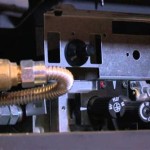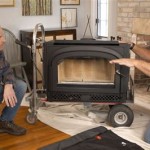Considerations for an Insert Wood Burning Fireplace
An insert wood-burning fireplace offers a practical and aesthetically pleasing solution for revitalizing an existing masonry fireplace. Instead of the open fireplace, which can be inefficient in terms of heat generation and energy consumption, an insert provides a closed combustion system designed to maximize heat output and minimize emissions. This article will delve into the key considerations associated with choosing, installing, and maintaining an insert wood-burning fireplace, aiming to provide comprehensive information for those considering this upgrade.
The primary function of a wood-burning fireplace insert is to transform an existing, often energy-inefficient, fireplace into a more effective heating appliance. Open fireplaces draw significant amounts of heated air from the room and exhaust it up the chimney, resulting in a net heat loss for the home. In contrast, an insert is a closed firebox built to fit within the existing fireplace opening. It contains the fire more completely and is designed to radiate significantly more heat into the room. Furthermore, many models incorporate blowers to circulate the heated air more effectively.
Sizing and Compatibility
One of the most crucial aspects of selecting an insert wood-burning fireplace is ensuring proper sizing and compatibility with the existing fireplace. Accurate measurements of the fireplace opening are essential. These dimensions include the width, height, and depth of the firebox. The manufacturer's specifications for the insert will provide the minimum and maximum fireplace opening dimensions required for safe and effective operation. Exceeding these limits can compromise the performance and safety of the insert.
Beyond the size of the firebox, the condition of the existing chimney is also a critical factor. A chimney inspection, preferably conducted by a certified professional, is highly recommended. The inspection will assess the chimney's structural integrity, identify any cracks or deterioration, and determine if it is properly lined. A damaged or unlined chimney poses a significant fire hazard and must be addressed before installing an insert. In many cases, a stainless steel chimney liner is required to meet safety codes and ensure proper drafting.
Furthermore, consider the heating needs of the space. Fireplace inserts are rated by their British Thermal Unit (BTU) output, which indicates the amount of heat they can generate per hour. Choosing an insert with an appropriate BTU rating for the size of the room or area to be heated is essential for achieving optimal comfort and energy efficiency. Overestimating the heating capacity can lead to overheating, while underestimating it will leave the space inadequately heated.
The insert's firebox size will also dictate the length of the wood that can be accommodated. If access to longer logs is easier, this should be considered during the selection process. Some models may also have features like adjustable legs or surrounds to achieve a flush and aesthetically pleasing integration with the existing fireplace.
Installation and Safety Regulations
The installation of an insert wood-burning fireplace should ideally be performed by a qualified and certified installer. While some homeowners may be tempted to undertake the installation themselves, adherence to local building codes and safety regulations is paramount. Improper installation can lead to fire hazards, carbon monoxide poisoning, and other serious risks. A professional installer will possess the necessary expertise, tools, and knowledge to ensure a safe and compliant installation.
Local building codes often dictate specific requirements for the installation of wood-burning appliances. These requirements may include minimum clearances to combustible materials, proper ventilation, and the installation of smoke detectors and carbon monoxide detectors. Failure to comply with these regulations can result in fines, insurance complications, and, more importantly, increased safety risks.
The installation process typically involves preparing the existing fireplace opening, installing the chimney liner (if required), connecting the insert to the chimney, and sealing any gaps around the insert to prevent air leaks. The installer will also conduct a thorough inspection and testing of the system to ensure proper operation and safety. This may include a smoke test to verify adequate drafting and a carbon monoxide test to ensure there are no leaks.
It is crucial to obtain all necessary permits before commencing the installation. Permits ensure that the installation is inspected and approved by local authorities, providing an additional layer of safety and compliance. Failure to obtain the required permits can result in costly fines and the need to redo the installation.
Ongoing safety measures include maintaining appropriate clearances around the insert, avoiding the storage of combustible materials near the appliance, and regularly inspecting the chimney for creosote buildup. Creosote is a highly flammable substance that can accumulate in the chimney over time, posing a significant fire hazard. Professional chimney sweeping is recommended at least once a year, or more frequently if heavy usage occurs.
Efficiency, Emissions and Fuel
The efficiency of an insert wood-burning fireplace refers to its ability to convert the energy contained in the wood into usable heat. Older, less efficient fireplaces can waste a significant amount of heat up the chimney, while newer, EPA-certified inserts are designed to burn cleaner and more efficiently. Choosing an EPA-certified model is highly recommended for both environmental and economic reasons.
EPA-certified inserts meet stringent emissions standards, reducing the amount of particulate matter and other pollutants released into the atmosphere. These inserts typically employ advanced combustion technologies, such as secondary air injection, to burn the wood more completely and reduce smoke production. This not only benefits the environment but also reduces creosote buildup in the chimney, lowering the risk of chimney fires.
The type of wood used to fuel the insert also plays a significant role in its efficiency and emissions. Seasoned hardwood, such as oak, maple, or ash, is the preferred fuel. Seasoned wood has a lower moisture content, which allows it to burn hotter and more cleanly. Green or unseasoned wood contains a higher moisture content, which reduces its heating value and increases smoke production. Burning green wood can also lead to increased creosote buildup.
Proper wood storage is essential for maintaining its quality. Wood should be stored in a dry, well-ventilated area, ideally off the ground, to prevent it from rotting or becoming infested with insects. A wood shed or covered stack is recommended. Allowing the wood to season for at least six months, or preferably longer, will significantly improve its burning performance.
Furthermore, proper burning techniques can also enhance efficiency and reduce emissions. Building a hot, clean fire is crucial. This involves using kindling to get the fire started and gradually adding larger pieces of wood. Avoid overloading the firebox, as this can restrict airflow and lead to incomplete combustion. Adjusting the air controls on the insert can also help to optimize the burning process. A smoky fire indicates incomplete combustion, which wastes fuel and increases emissions. A clean-burning fire with minimal smoke is a sign of efficient combustion.
Consider the long-term cost of fuel when choosing an insert. The price of firewood can vary depending on location and availability. Evaluate the cost per cord and the expected wood consumption to determine the overall heating expenses. While wood can be a relatively inexpensive fuel source, it requires manual handling and storage. Alternative fuel options, such as wood pellets, are available for some insert models, offering a more convenient and cleaner-burning alternative.
In summary, the selection, installation, and operation of an insert wood-burning fireplace require careful consideration of several factors. Sizing, compatibility, safety regulations, efficiency, emissions, and fuel choices all play a crucial role in ensuring a safe, effective, and enjoyable heating experience. Thorough research, professional consultation, and adherence to best practices are essential for maximizing the benefits of this efficient and aesthetically pleasing heating solution.

Wood Burning Fireplace Inserts Insert Installation

Why A Wood Burning Fireplace Insert Bethesda Md Service

Wood Inserts We Love Fire

Quadra Fire Expedition I Wood Insert Fireside Hearth Home

Nova Wood Burning Stove Insert Ca Mf Fire

Stuv 16 In Z Wood Burning Insert Or Zc Fireplace Mazzeo S Stoves Fireplaces

Ventis Hei240 Wood Burning Insert Rockford Chimney

Fireplace Insert Guide Fireplaces Direct Learning Center

Wood Burning Fireplaces Inserts Full Service Chimney

Supreme Fireplaces








